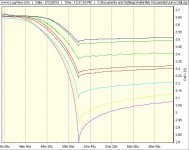If you HK cells need balance every 4th run,, then you are beating them like the dog that shit inside your shoe.
Same will result with any other cell you beat. Discharge rate + depth of discharge my man. Get that pack all hot,, bet it needs a balance. Maybe you just define balanced different than I do.
Don't need to undercharge to keep the balance,, the undercharge is to give you the head room to call .05 off plenty balanced enough when naked charging. If you want your pack to stay balanced to .01, then A you need more accurate measuring device than any hobby charger, and B, you need balance every cycle.
The way I use my hobby king shit,, I balance about 4 times a year. Generally, I never see "unbalanced" even then,, which I call .1v off.
I use an RC charger when I do balance, but not like you think. I just discharge one high cell, or charge one low cell. Generally in a 14s 2p pack, I might find two cells that need adjustment. Charge or discharge the off cell through the balance wires. On the road, like on a tour,, discharge a high cell with a 12v light bulb.
Oh,, and unless somebody out there hasn't read it yet,, store and charge your naked packs, like HK cells, where you would willingly build a fire.



